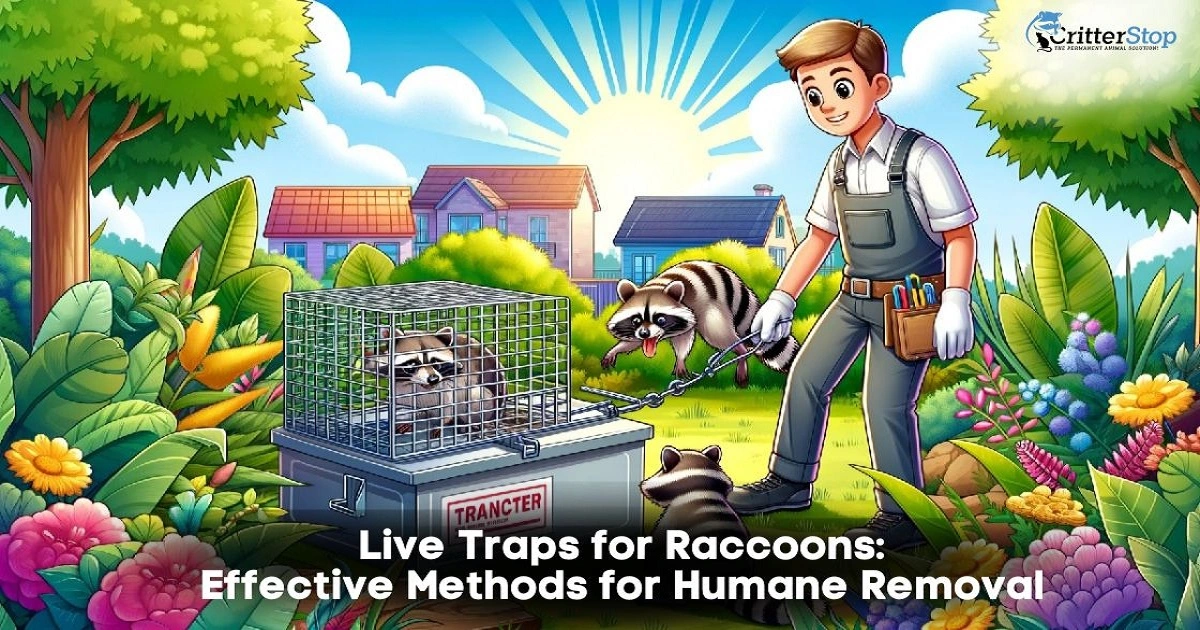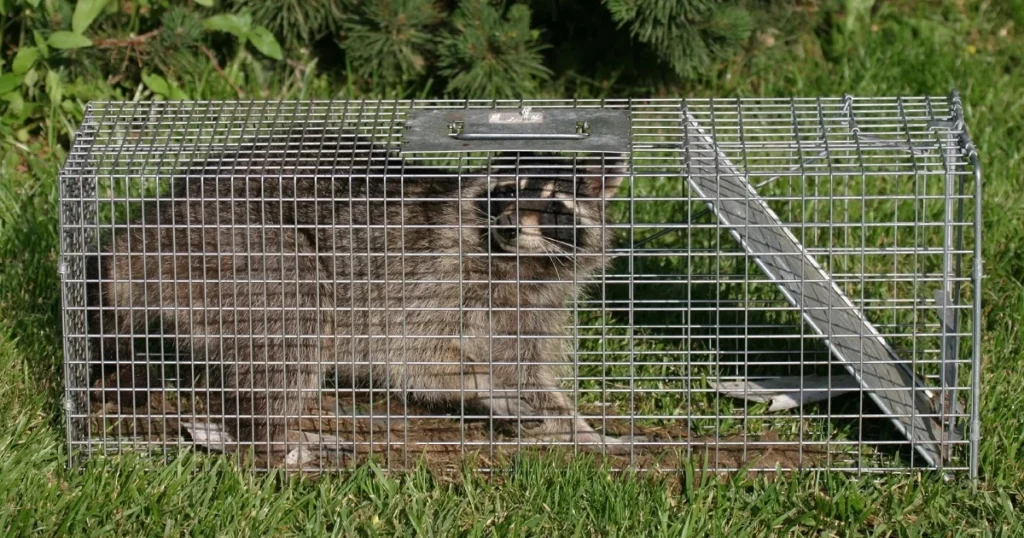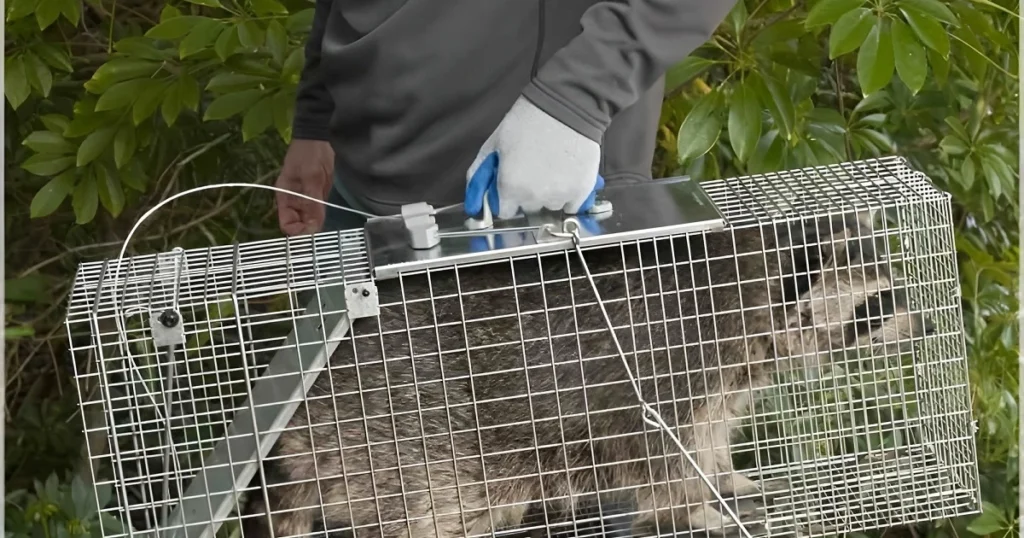
Live traps for raccoons have become an increasingly popular method for removing these pesky critters from residential and commercial properties. Raccoons are known for their ability to wreak havoc on gardens, trash cans, and even homes. While there are many methods for deterring raccoons, including using repellents and fencing, live trapping is often the most effective and humane solution.
Live traps are designed to catch raccoons without harming them, allowing them to be safely relocated to a new area. These traps come in various sizes and styles, ranging from small cage traps to larger box traps. When using a live trap for any animal, it is important to choose the right size and type of trap for the job and follow proper trapping and relocation procedures to ensure the safety of the raccoon and the person doing the trapping.
Raccoons are nocturnal and are commonly found in North America. They are well-known for their unique black mask and ringed tail. Raccoons are omnivores, and they will eat just about anything they can find, including fruits, nuts, insects, small animals, and even garbage. They are also known for their cunning ability to adapt to various environments, which makes them a common sight in both urban and rural areas.
Raccoons are most active at night, so it can be difficult to spot them during the day. However, there are a few signs that identify their activity. One of the most common signs is simply the presence of raccoon droppings, which are usually found near their den or feeding areas. Raccoons also have a distinctive paw print, which their five toes and long claws can identify. They are also known for their ability to open trash cans and other containers, so if you notice any overturned trash cans or scattered garbage, it could be a sign of raccoon activity.
Raccoons are extremely adaptable and can live in various habitats, including forests, wetlands, and suburban areas. They can climb trees and swim well, which makes them well-suited to living near water sources. Raccoons typically build their dens in hollow trees, rock crevices, or other natural cavities. In urban areas, they may also build their dens in attics, crawl spaces, or chimneys.
Live traps are often used to capture raccoons without harming them. These traps are designed to lure the raccoon inside with bait and then trap it without causing any harm. It is important to place the trap where raccoon activity has been identified, such as near their den or feeding area. Once the raccoon has been trapped, it should be released in a safe location away from human habitation.

When it comes to trapping raccoons, there are several types of live traps available on the market. Each trap has its own unique features and benefits. In this section, we will discuss the most commonly used types of live animal traps for raccoons.
Cage traps for raccoons are the most commonly used type of trap. These traps are made of wire mesh and are designed to capture raccoons without harming them. The cage trap is baited with food, and when the raccoon enters the trap, the door closes behind it. Cage traps are available in different sizes, so make sure to choose the right size to ensure that the raccoon is not injured while in the trap.
Box traps for raccoons are similar to cage traps, but they are made of solid materials such as wood or plastic. These traps are also designed to capture raccoons without harming them. Box traps are often used in areas where cage traps are not practical, such as in attics or crawl spaces.
Foothold traps for raccoons are designed to capture raccoons by their feet. Professional trappers often use these traps, which require a certain level of skill to set up properly. Foothold traps are not recommended for inexperienced trappers, as they can cut or injure the raccoon if not set up correctly.
Dog proof traps for raccoons are designed to capture raccoons without harming them and are often used in areas where pets are present. These traps are baited with food, and when the raccoon enters the trap, the door closes behind it. Dog proof traps are designed in such a way that only a raccoon can trigger the trap, making them safe for pets.
In conclusion, choosing the right type of live trap for raccoons depends on the specific situation and the trapper's level of experience. Cage traps and box traps are the most commonly used types of traps, while foothold traps and dog-proof traps are used by professional trappers or in areas where pets are present. It is important to use traps that are humane and do not harm the raccoon.

When it comes to trapping raccoons, using a live trap is a humane and effective method. However, not all live traps are created equal. Here are some things to consider when choosing the best live trap for raccoons.
The size and design of the trap are important considerations. Raccoons are typically larger than other common pests, so a trap that is too small will not be effective. Look for a trap that is at least 32 inches long and 10 inches wide. Additionally, a trap with a sturdy, solid door is important to prevent the raccoon from escaping or injuring itself.
The material and durability of the trap are also important factors to consider. A trap made from flimsy materials may not hold up to the strength of a raccoon. Look for a trap made from sturdy materials such as galvanized steel or heavy-duty wire mesh. Additionally, a trap with a rust-resistant coating will ensure it lasts for multiple uses.
After researching and comparing various live traps for raccoons, the Havahart X-Large 1-Door Trap stands out as a good option. It meets the size and design requirements, with dimensions of 42 inches long and 15 inches wide and a solid door to prevent escape. It is also made from durable, galvanized steel with a rust-resistant coating for long-lasting use.
Overall, when choosing a live trap for raccoons, it is important to consider the size, design, material, and durability of the trap. The Havahart X-Large 1-Door Trap meets all of these requirements and is a reliable choice for humanely capturing raccoons.

When it comes to live trapping raccoons, baiting the trap is a crucial step to ensure success. Raccoons are known to be and can be attracted to various foods. However, it is important to note that raccoons have their favorite foods, and using them as bait can increase the likelihood of trapping them.
Some of the most effective baits for raccoons include sweet corn, marshmallows, cat food, sardines, and peanut butter. It is recommended to use fresh, high-quality baits to ensure maximum effectiveness. Additionally, it is important to avoid using baits that are toxic or harmful to raccoons.
The placement of bait in a live trap can also play a significant role in trapping raccoons. Placing the bait in the center of the trap can increase the chances of trapping the raccoon, as it will be forced to step on the trigger plate to reach the bait.
It is also important to consider the location of the trap when placing the bait. Placing the trap in areas where raccoons are known to frequent, such as near garbage cans or in gardens, can improve your odds of trapping them.
In conclusion, selecting the right bait and placing it strategically can significantly increase the chances of trapping raccoons in live traps. It is important to use fresh, high-quality baits and avoid using baits that are toxic or harmful to raccoons.

When it comes to live trapping raccoons, proper trap setup is crucial for success. This section will cover two primary aspects of setting up the trap: location and safety precautions.
Choosing the right location for the trap is key. Raccoons are most active at night, so it's best to set up the trap in the evening and check it in the morning. Try to find areas where raccoons frequently appear, such as near garbage cans or in wooded areas. Make sure to place the trap on level ground and secure it to prevent it from tipping over.
It's important to take safety precautions when setting up a live trap for raccoons. Raccoons can be aggressive, like most animals, when cornered or threatened, so it's best to wear gloves and use caution when handling the trap. Make sure to keep young children, elderly, and pets away from the trap, as they may accidentally trigger it. If you plan on releasing the raccoon in a different location, make sure it's legal to do so in your area and that you release it in a suitable habitat.
By following these tips, you can increase your chances of successfully trapping a raccoon using a live trap. Remember to always handle traps with care and respect for the animal's well-being.

Live traps for raccoons are an effective way to capture these critters without harming them. However, it is essential to check and maintain the traps regularly to ensure that they are functioning correctly and do not harm the raccoons.
It is crucial to inspect the live traps regularly to verify that they are in working condition. Check the trap's trigger mechanism, door, and locking mechanism for signs of damage - this often happens after an animal has been trapped and is trying to escape. If any parts are damaged, replace them immediately to prevent the raccoons from escaping or getting injured.
Inspect the trap's bait to ensure that it is still fresh and appealing to raccoons. If the bait is old or stale, replace it with fresh bait to increase the chances of trapping the raccoons.
It’s recommended that the trap be cleaned thoroughly after each use to prevent the spread of diseases and parasites. Wear gloves while cleaning the trap and use a disinfectant. Rinse the trap with water and allow it to dry completely before storing it.
Store the trap somewhere dry to prevent rusting and damage. You can also try covering the trap with a tarp or another covering to protect it from the elements.
In conclusion, checking and maintaining live traps for raccoons is crucial to ensure that they function correctly and do not harm the raccoons. Regular inspection and cleaning of the traps can increase their lifespan and effectiveness in trapping raccoons.
Before setting up a live trap for raccoons, it is important to research local regulations regarding the trapping and relocation of wildlife. Some states and municipalities have specific laws and regulations regarding trapping and relocation, and failure to comply with these regulations can result in fines or other legal consequences.
In addition, it is important to consider the potential impact on other wildlife and ecosystems in the area. For example, relocating a raccoon to a new area could potentially introduce diseases or disrupt the local ecosystem.
When setting up a live trap for raccoons, humane trapping practices are important to minimize stress and injury to the animal. This includes ensuring that the trap is the appropriate size for the animal, providing adequate food and water while the animal is in the trap, and checking the trap regularly to minimize the amount of time the animal spends in it.
Once the raccoon has been trapped, it should be handled carefully to avoid injury or stress. It is important to wear gloves and use caution when releasing the animal, as raccoons can be aggressive and may carry diseases such as rabies.
Overall, when using live traps for raccoons, it’s important to consider the legal and ethical implications of trapping and relocation and use humane trapping practices to minimize harm to the animal.

When handling a trapped raccoon, it is important to take the necessary precautions to prevent injury to the animal and the handler. The raccoon should be approached slowly and calmly, speaking in a low and soothing tone to avoid startling it. Thick gloves should be worn to protect against bites, scratches, and the potential transmission of diseases.
Once the raccoon is safely restrained, it should be placed in a well-ventilated carrier or transport box. The carrier should be large enough to allow the raccoon to move around comfortably but small enough to prevent it from injuring itself. The carrier should also be secured in the vehicle to prevent it from sliding around during transport.
When relocating a trapped raccoon, it is important to choose a suitable release site that is at least 10 miles away from the capture location. The release site should have a natural source of water and food, such as a stream or pond, and be free from potential hazards, such as busy roads or areas with high human activity.
Before releasing the raccoon, it is important to ensure it is healthy and free from any signs of illness or injury. The raccoon should be released in a quiet and secluded area, away from other animals, to prevent potential conflicts.
We want to point out that relocation should only be considered as a last resort if the animal is causing damage to your property or livestock, as it can be a stressful experience for the animal and may disrupt the local ecosystem. Before relocating, you can contact a licensed wildlife rehabilitator or animal control professional for assistance with raccoon removal and relocation.
Raccoons are intelligent and persistent animals. They can often find their way back into an area after being trapped and removed. To prevent raccoons from re-entering an area, certain measures must be taken to secure it and prevent access. This section will cover two main methods for preventing raccoon re-entry: securing trash and compost and exclusion techniques.
Raccoons are attracted to areas with a ready food supply, and trash and compost are two common sources of food. To prevent raccoons from accessing these areas, it is important to secure them properly. This can be done by using a secure trash can with a tight-fitting lid, and by storing compost in a secure bin that is inaccessible to raccoons. It is also important to keep the area around the trash and compost clean and free of food debris.
Exclusion techniques involve physically preventing raccoons from accessing an area. This can be done by sealing off any potential entry points, such as gaps in walls or roofs, or by installing barriers such as fences or netting. It is important to ensure that any barriers or seals are secure and cannot be easily bypassed by raccoons.
In addition to these methods, it is important to regularly inspect the area for signs of raccoon activity, such as footprints or droppings. If any signs are found, it may be necessary to take additional measures to prevent re-entry.
By taking these steps to prevent raccoon re-entry, it is possible to keep these animals out of an area and avoid the damage and nuisance they can cause.
There are several deterrents and repellents available in the market that can sometimes keep raccoons away from your property. While they do not always work, they can be a cost-effective alternative to live trapping. These include:
If you have a persistent raccoon problem, it's advisable to seek the help of a professional wildlife removal company such as Critter Stop. Our company has the expertise and equipment to safely and humanely remove raccoons from your property. We may use methods such as:
It's best to be safe and choose a reputable wildlife removal company that adheres to humane practices and local laws and regulations. If you have raccoons causing a mess on your property and need them relocated, just give us a call at (214) 234-2616, and we can set up a free visit and quote to help you solve your problem.

For those who want to learn more about live trapping raccoons, there are a variety of educational materials available. Many state wildlife agencies offer free guides and brochures on humane raccoon control methods, including live trapping. These materials often provide detailed instructions on how to use live traps safely and effectively, as well as tips for releasing trapped raccoons back into the wild.
In addition, many online resources are available for those who want to learn more about live trapping raccoons. Websites such as the Humane Society of the United States and the National Wildlife Control Operators Association offer helpful guides and articles on live trapping and information on finding a qualified wildlife control professional in your area.
For those who are not comfortable using live traps themselves or who have a large raccoon infestation that requires professional assistance, there are many wildlife control professionals who specialize in humane raccoon control methods. If you’re in Texas, you can call Critter Stop.
We have professionals trained to safely and effectively use live traps to capture raccoons. We can often provide additional services such as exclusion and habitat modification to prevent future infestations. Give us a call for a free consultation at (214) 234-2616; you’ve got nothing to lose!
When choosing a wildlife control professional, it is important to do your research, read online reviews, and/or ask friends and neighbors about their experience. You can check our reputation on multiple aggregator websites such as Google, Thumbtack, and Proche.
The best bait to use in a live trap for capturing raccoons is sweet and aromatic, like marshmallows, watermelons, tuna, cat food, or honey. Raccoons are attracted to sweet smells and will be more likely to enter the trap if they smell something they like.
Live traps are very effective in capturing raccoons. They are designed to be humane and safe for the raccoon and the person setting the trap. However, it's important to remember that raccoons are intelligent and may be difficult to trap. It may take several attempts before a raccoon is successfully trapped.
Several reliable brands of live traps are available for capturing raccoons, including Havahart, Tomahawk, and Duke. These brands have a proven track record of success and are designed to be safe and humane for the raccoon and the person setting the trap.
If a raccoon is avoiding live traps, there are a few things you can try. First, try changing the bait you're using to something sweeter and more aromatic. You can also try moving the trap to a different location, as raccoons may be avoiding the trap because they feel unsafe in that area. Finally, you can try covering the trap with a blanket or tarp to make it feel more like a den, which may make the raccoon feel more comfortable entering.
While raccoons survive many days without food or water, we strive to relocate animals as quickly as possible. It's important to check the trap regularly - at least once every 24 hours - and release the raccoon as soon as possible to minimize stress and discomfort on the animal.
Yes, there are several humane live traps available designed to catch raccoons while keeping dogs safe. While we cannot vouch for these traps specifically, a few options that we found online include:
The Havahart 1089 Collapsible One-Door Live Animal Cage Trap: This trap features a gravity-action door that securely locks once the raccoon enters. The mesh design prevents dogs from reaching inside while still allowing raccoons to trigger the trap.
The Tomahawk Original Series Rigid Trap with Easy Release Door: This trap is constructed with sturdy wire mesh and has a sensitive trigger mechanism. It's designed to safely catch raccoons without harming them, while keeping larger animals like dogs at bay.
The Duke Dog-Proof Coon Trap: Specifically engineered to catch raccoons while preventing dogs from accessing the bait, this trap has a unique design with a spring-loaded mechanism that only activates when a raccoon enters.
Visit our Critter Library and learn more about our furry friends